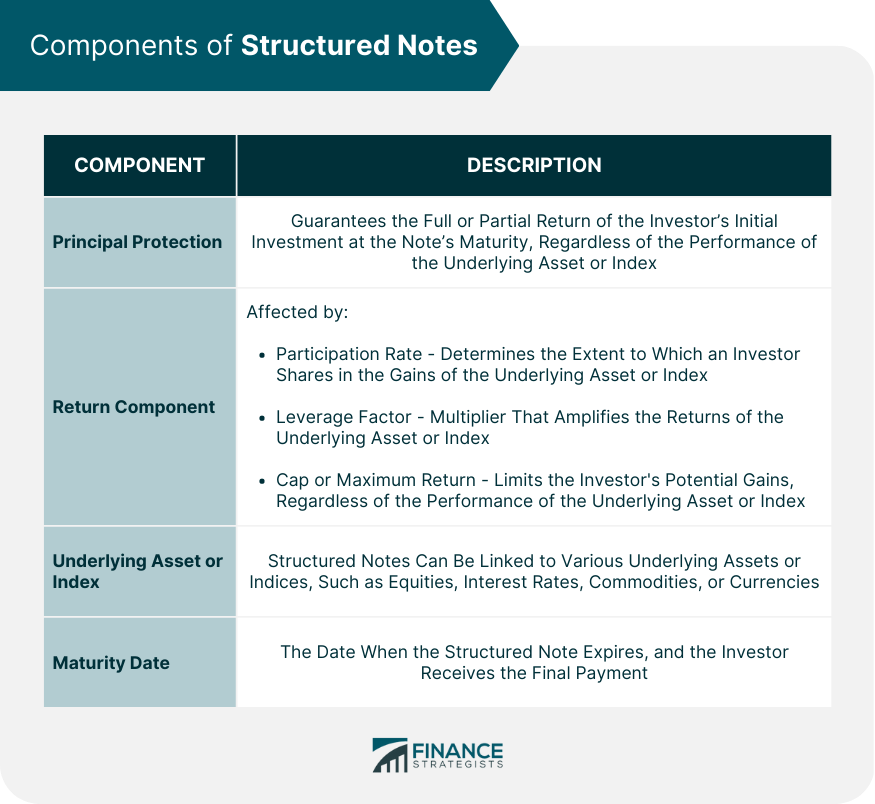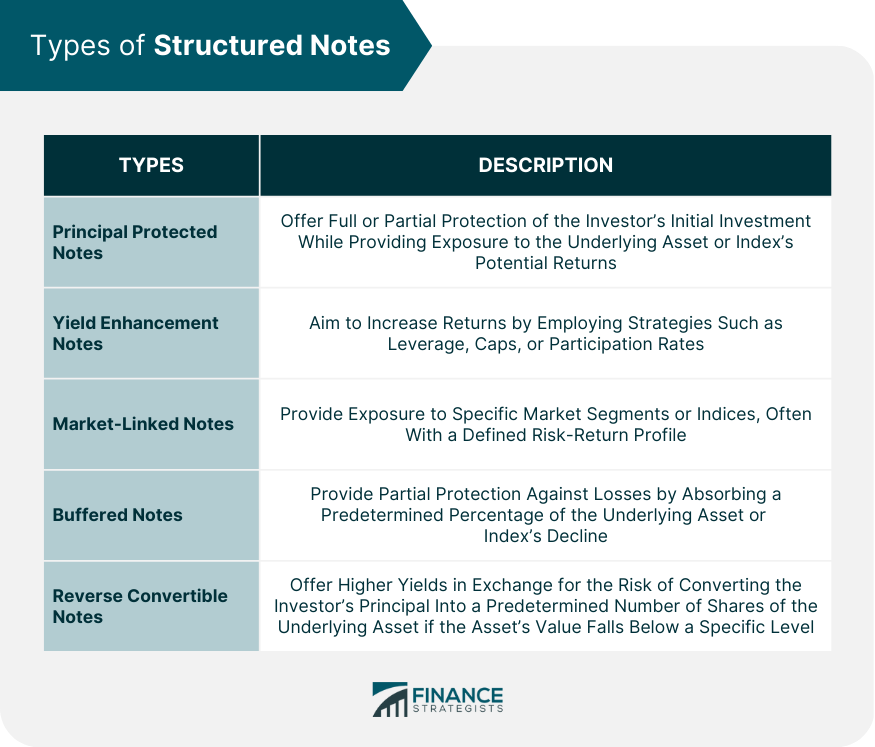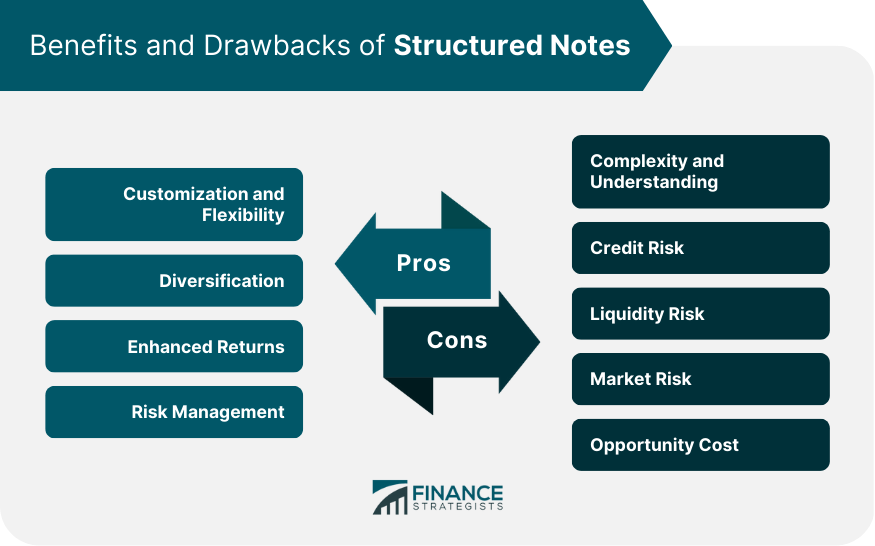Structured notes are financial instruments that combine the features of debt securities and derivatives to provide investors with a customized risk-return profile. These hybrid securities are typically issued by financial institutions and are designed to meet specific investment objectives, such as principal protection, yield enhancement, or market exposure. Common types include principal protected notes, yield enhancement notes, market-linked notes, buffered notes, and reverse convertible notes. Structured notes offer various benefits, such as customization, diversification, and enhanced returns. However, they also come with inherent risks, including complexity, credit risk, liquidity risk, market risk, and opportunity cost. Principal protection is a feature that guarantees the return of the investor's initial investment, either partially or fully, at the note's maturity, regardless of the performance of the underlying asset or index. The participation rate determines the extent to which an investor shares in the gains of the underlying asset or index. For example, if the participation rate is 80%, the investor will receive 80% of the increase in the value of the underlying asset or index. The leverage factor is a multiplier that amplifies the returns of the underlying asset or index. If the leverage factor is 2, for instance, the investor would receive twice the return of the underlying asset or index. A cap is a predetermined maximum return that limits the investor's potential gains, regardless of the performance of the underlying asset or index. Structured notes can be linked to various underlying assets or indices, such as equities, interest rates, commodities, or currencies. The maturity date is the date when the structured note expires, and the investor receives the final payment, which may include the principal and any returns based on the performance of the underlying asset or index. Principal protected notes offer full or partial protection of the investor's initial investment while still providing exposure to the underlying asset or index's potential returns. Yield enhancement notes aim to increase returns by employing strategies such as leverage, caps, or participation rates. Market-linked notes provide exposure to specific market segments or indices, often with a defined risk-return profile. Buffered notes provide partial protection against losses by absorbing a predetermined percentage of the underlying asset or index's decline. Reverse convertible notes offer higher yields in exchange for the risk of converting the investor's principal into a predetermined number of shares of the underlying asset if the asset's value falls below a specific level. Structured notes can be tailored to meet individual investor needs, offering a wide range of risk-return profiles and investment strategies. Structured notes can provide exposure to various asset classes or market segments, helping investors diversify their portfolios. Structured notes can potentially deliver higher returns than traditional investments, depending on the performance of the underlying asset or index. Structured notes can offer risk management features, such as principal protection or buffered returns, to help investors manage their exposure to market volatility. Structured notes can be complicated financial instruments, making it difficult for some investors to fully understand their features, risks, and potential returns. Investors face credit risk, as the issuer's ability to meet its obligations depends on its financial health. If the issuer defaults, the investor may not receive the promised returns or even their initial investment. Structured notes may have limited secondary market liquidity, which could make it difficult for investors to sell their notes before maturity, potentially leading to losses. Structured notes are subject to market risk, as their returns depend on the performance of the underlying asset or index, which can be volatile and unpredictable. Investing in structured notes may involve an opportunity cost, as investors may miss out on better-performing investments if the underlying asset or index does not perform as expected. Investors should consider their investment objectives and whether structured notes align with their goals, such as capital preservation, income generation, or growth. Structured notes may be suitable for investors with varying risk tolerances, but it is crucial to understand the potential risks and rewards associated with these instruments. Investors should consider their investment time horizon, as structured notes typically have fixed maturity dates, and early redemption may be difficult or result in losses. Structured notes can be a valuable addition to a diversified portfolio, offering exposure to different asset classes or market segments. Structured notes are subject to regulation by key financial regulatory bodies, such as the Securities and Exchange Commission (SEC) in the United States and the Financial Conduct Authority (FCA) in the United Kingdom. Issuers of structured notes are required to provide investors with detailed disclosure documents, including prospectuses and offering circulars, outlining the features, risks, and potential returns of the notes. Regulatory bodies enforce investor protection measures to ensure transparency, fair practices, and adequate disclosure of information related to structured notes. Structured notes can offer attractive benefits, but they also come with inherent risks. Investors should carefully evaluate these instruments to determine if they align with their investment objectives, risk tolerance, and diversification needs. Investing in structured notes requires carefully assessing the potential risks and rewards and balancing attractive returns and prudent risk management. As the structured notes market continues to evolve, new products and strategies may emerge, offering investors additional opportunities for customization, diversification, and risk management. Consult a qualified financial advisor or wealth management professional for further guidance on structured notes and how they can help investors achieve their goals.What Are Structured Notes?
Components of Structured Notes
Principal Protection
Return Component
Participation Rate
Leverage Factor
Cap or Maximum Return
Underlying Asset or Index
Maturity Date

Types of Structured Notes
Principal Protected Notes
Yield Enhancement Notes
Market-Linked Notes
Buffered Notes
Reverse Convertible Notes

Advantages of Structured Notes
Customization and Flexibility
Diversification
Enhanced Returns
Risk Management
Disadvantages and Risks of Structured Notes
Complexity and Understanding
Credit Risk
Liquidity Risk
Market Risk
Opportunity Cost

Suitability and Considerations for Investors
Investment Objectives
Risk Tolerance
Time Horizon
Diversification Needs
Regulatory Environment and Disclosure Requirements
Key Regulatory Bodies
Disclosure and Reporting Requirements
Investor Protection Measures
The Bottom Line
Structured Notes FAQs
Structured notes are hybrid financial instruments that combine debt securities and derivatives to offer investors customized risk-return profiles. They can benefit your portfolio by providing diversification, enhanced returns, risk management, and tailored investment strategies.
The primary risks associated with structured notes include complexity, credit risk, liquidity risk, market risk, and opportunity cost. It is essential to understand these risks before investing in structured notes to ensure they align with your risk tolerance and investment objectives.
Different types of structured notes serve varying investment purposes. Principal protected notes offer full or partial protection of the initial investment while providing exposure to potential returns. Yield enhancement notes aim to increase returns using strategies such as leverage, caps, or participation rates. Each type has its unique risk-return profile to cater to different investor needs.
When evaluating structured notes for your investment portfolio, consider your investment objectives, risk tolerance, time horizon, and diversification needs. Ensure that the structured notes align with your goals and understand their features, risks, and potential returns.
Yes, structured notes are regulated by key financial regulatory bodies, such as the Securities and Exchange Commission (SEC) in the United States and the Financial Conduct Authority (FCA) in the United Kingdom. These regulators enforce investor protection measures, including transparency, fair practices, and adequate disclosure of information related to structured notes.
True Tamplin is a published author, public speaker, CEO of UpDigital, and founder of Finance Strategists.
True is a Certified Educator in Personal Finance (CEPF®), author of The Handy Financial Ratios Guide, a member of the Society for Advancing Business Editing and Writing, contributes to his financial education site, Finance Strategists, and has spoken to various financial communities such as the CFA Institute, as well as university students like his Alma mater, Biola University, where he received a bachelor of science in business and data analytics.
To learn more about True, visit his personal website or view his author profiles on Amazon, Nasdaq and Forbes.











